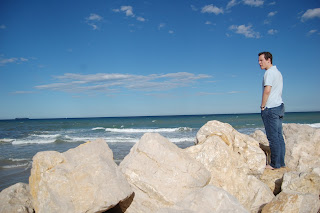Health insurance is a rather mundane topic, but it is important to planning a sabbatical. And, after much confusion, consultation, and deliberation, I am happy to say that we do have insurance. If you're bored already, I wouldn't recommend continuing to read. Just stop now. You can be happy for us that we have insurance and move on to more fun pursuits. I'm just going to go over the dull details below. You've been warned.
We have been blessed in receiving awesome health care coverage thru Brandon's workplace. Thankfully we were able to retain that coverage thru July 31 by using up Brandon's PTO and taking advantage of a company policy that provides insurance for the full month as long as you've worked at least one day of that month (thank you PTO).
After July 31, we would receive a COBRA notice and be able to take that as our insurance. But, here's where your company providing awesome insurance is a double-edged sword. Awesome coverage = huge cost. And, that huge cost we would now be solely responsible for. So, taking COBRA was not going to fit into our sabbatical budget and we needed to look into other options.
Many people have asked us whether we will find coverage in the Health Insurance Marketplace thru Obamacare and the Affordable Care Act. Well, we looked into that and we are not eligible. We do not fall under a Qualifying Life Event to get insurance immediately following July 31 because we are eligible for COBRA. So, we would have to wait for Open Enrollment on November 1 and take the expensive COBRA in the meantime. Not a good option for us.
So, we scoured the internet and read some blogs for other healthcare options. In doing so, we discovered some expat plans. These seemed valuable on the outset with our mixture of international and domestic travel for the year. However, we discovered the stateside coverage was not very good, and the plan did not fall under the Affordable Care Act requirements resulting in a fine. It did not seem wise to have to pay both an insurance premium and the fine.
We were back to square one with seemingly millions of private insurance options to sift through. A coworker of mine suggested talking to a local insurance agent, which turned out to be immensely helpful. The agent helped us quickly navigate the options. Together we determined that the cheapest course of action was to purchase a private domestic insurance plan approved by the Affordable Care Act and a separate international travel insurance plan.
First, we had to decide if we wanted a HMO or PPO plan. A PPO plan was better for us since we would be traveling all over the country throughout the year and finding doctors within a limiting HMO network could be a problem.
Then, we had to decide what we wanted to pay for premiums versus deductibles. That was easy. We are young (at least I am...Brandon has crept on to 30 now!) and healthy. We wanted the cheapest premiums (though this usually means a high deductible), which resulted in a HSA.
Finally, for insurance carriers, the main choices were Blue Cross Blue Shield (BCBS) or Priority Health. We preferred BCBS because its national recognition would streamline the paperwork behind any care we would need in our travels throughout the country, whereas Priority Health is more West Michigan based and lesser known.
We were pleased to discover that BCBS' HSA was cheaper than Priority Health's. Decision made. As of August 1, we now have a BCBS HSA!
It was all a very excruciatingly adult experience. If you're bored by now, I'm not surprised. I also have no sympathy. I warned you!
After all that you may ask, why didn't you just go without insurance and pay the fine? You are young and healthy, aren't you? Well, yes, but we are also very active with rock climbing, snowboarding, trampolining, cliff jumping, and who knows what other wild pursuits, and we (aka I) are accident prone with coffee tables (they just jump right out in front of me... seriously). Insurance is...well, insurance against the unknowns in life. We don't want to stop our sabbatical early and drown in healthcare debt.
These activities are also why we will invest in some travel insurance. This insurance is bare bones providing assistance and coverage of just emergency medical expenses, emergency medical evacuation, repatriation of remains, or accidental death and dismemberment. These are not at all common occurrences, so the plans are super cheap...we're talking like only three to four dollars per day per person. God forbid we would actually need to use the insurance, but if we did, those few dollars a day would save us hundreds of thousands of dollars.
We haven't purchased travel insurance yet, but it seems fairly easy. We can buy it right before we go abroad, make sure it covers the sports we want to do, and pay only for the days that we are traveling internationally. There are a bunch of companies to choose from, and when we decide on one we'll let you know.
So, if you're not sleeping yet, those are the logistics of our health insurance plan. Now back to the fun parts of taking a sabbatical!































